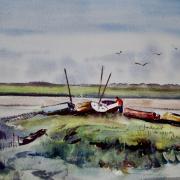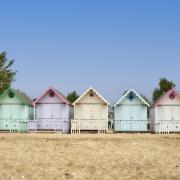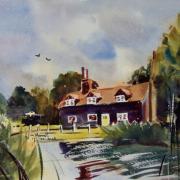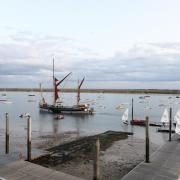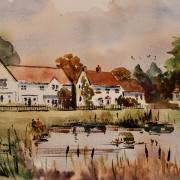Dotted along the Essex shoreline is a foray of rainbow-coloured ‘sheds’, more affectionately referred to as ‘beach huts’. Every year, thousands of people flock to these quintessentially British seaside abodes and attract equally as much curiosity from those who do not belong to the ‘hutter’ community.
Dr Nancy Stevenson an academic writer, author, and researcher, who owns a home in Frinton-on-Sea, and regularly walks the Tendring coastline, was intrigued by the concept. “I like to be on the go,” says Nancy, “and it just piqued my interest that so many people just come to the seaside to sit around in beach huts. I didn’t get it.”
Nancy, an active individual who also enjoys sailing, paddleboarding and kayaking, especially around ‘the Naze’ backwaters, understands the draw of the water, the sea air, and all that comes with time spent on the beach, but she couldn’t comprehend the attraction of spending the day in a deckchair, watching others stroll the promenade - while eating bacon rolls and sipping cups of tea.

“I’m naturally inquisitive,” says Nancy. “I like nothing more than striking up a conversation with people, despite how embarrassing my son finds it." This natural curiosity enabled Nancy to approach the beach-hut owners and users, once she'd come up with the idea for her recently launched book Beach Hut People.
Nancy has asked the questions so many of us ponder when we walk along the seafront, bemused by the crowds gathered there or perplexed by a hut’s name, a colour choice or its theme. In her book, Nancy seeks to find the answers to the questions we ‘non-hutters’ want to know.
Beach Hut People features the memories, stories and anecdotes from around 60 beach-hut owners or frequent hut users along the North Essex coast, specifically the Tendring Parish peninsula between Walton-on-the-Naze and Frinton-on-Sea. The Tendring district boasts more than 3,000 beach huts, spread from Harwich through Dovercourt, Walton, Frinton, Clacton, St Oysth and Brightlingsea, with over 1,000 huts between Walton and Frinton alone.

Through tales from 'hutter', Nancy has discovered common reasons for ownership, the naming of beach huts, and the importance of location. “There are a lot of similarities behind the reasons for ownership, mostly of families coming together, of childhood memories relived, or huts being in the same family for generations,” says Nancy. Hut owner, Sarah says in the book, “It’s an escape, it reminds me of my childhood. It’s just idyllic”.
Predominantly the book contains fond memories of days at the seaside, friendships made and community spirit shared. All the stories within its pages are generally expressed with warmth and affection, not just about people but the huts too. Hut owner Anna told Nancy, “We had been talking about getting a beach hut for a few years and we had looked at a few. And then at Christmas, unbeknown to me, my husband looked at ‘Pearl’ and he organised the purchase. So on Christmas morning we opened a little gift bag with some keys in it.”.
Nancy ascertains why people buy the huts they do, why they adorn them with nick-nacks, beach or other paraphernalia and ephemera. She uncovers the reason for a theme and is bewildered by the styling; from lavish, decadent, and perfectly styled huts filled with Cath Kidson designer accessories to the more functional utilitarian huts that are used as a base to store beach baggage; those things we need every day on the beach but don’t want to lug backwards and forwards each time we visit. There are huts with traditional-style deckchairs, camping tables and plastic plates while others have storage spaces for surfboards and kayaks. Most have blankets, cushions, and other soft furnishings, some handcrafted, others gifted, or sourced from charity shops.
There are similarities, in the stuff people have; the usual practical things for a day at the beach, but Nancy was equally fascinated by the more peculiar and personal items. Fred, a reluctant owner at first, now loves his hut; “I made the sign and inside we have a collection of old postcards. You know, those old ones that were right on the limit - saucy postcards with double meanings…”

Nancy has also learned that the huts are used as a communal space, somewhere in which people can come together; for family gatherings and celebrations including birthdays, Christmas and New Year. We may think of the huts as only summer dwellings but there are no restrictions to using them all year round. The beauty of beach-hut ownership means it is there for when you want to use it, and many owners take pleasure in coming down to the beach on a cold winter’s day, putting the kettle on for a brew and even cooking up an English breakfast. For others, it’s a place to barbecue, grab fish and chips for tea, and enjoy a pint of beer or a glass of wine or two. Hut owner Helen explains, “Dad died on New Year’s Eve and the following year we all came down in our winter coats and we brought sloe gin to drink, to toast him, because it is such a special place for us”.
Another hut-owner, Sue, fondly remembers long pleasurable summers at the hut: “You can transport yourself when you are here. I have got loads of special memories of being with everybody. All the family and lots of different people, sitting on the steps and laughing and enjoying being here. Every day was a special day when we came down”.
Beach Hut People also explores Nancy’s journey and the personal experiences that have transformed her perspective on beach huts. She was initially sceptical about them, due to past unfavourable encounters, including one on a chilly, grey August day, with the wind whistling through the front-door hatch. She remembers: “It starts to drizzle after about an hour and we bring damp clothes, sandy towels and fold-up chairs into the hut. We drink tea and eat gritty sandwiches in the cramped, cold, dank, squalid interior.”

Nancy concludes that regardless of whether one is a 'hutter' or not, “we all love this stretch of the coastline and visit it regularly. We walk on the sand at low tide, we paddle, we swim, we love to watch other people at the beach, and to gaze out over the sea towards the windfarms and the horizon”.

Beach Hut People is a collaborative project between Nancy and Publishing Household, a local niche publishing company founded by Eleanor Brown, proprietor of The Nose Bookshop in Walton-on-the-Naze. In joining forces, Nancy and Eleanor recognised the potential of bringing their respective ideas to fruition in a joint venture.
Beach Hut People is available from:
The Noze Bookshop, Walton on the Naze
Caxton Books, Frinton on Sea
Red Lion Books, Colchester
Manningtree Arts, Manningtree
Maldon Books, Maldon












